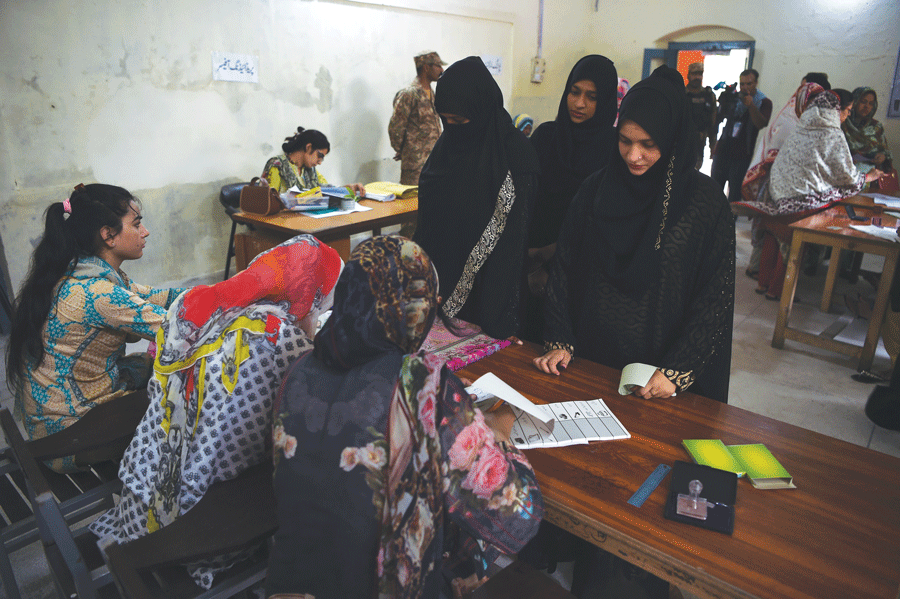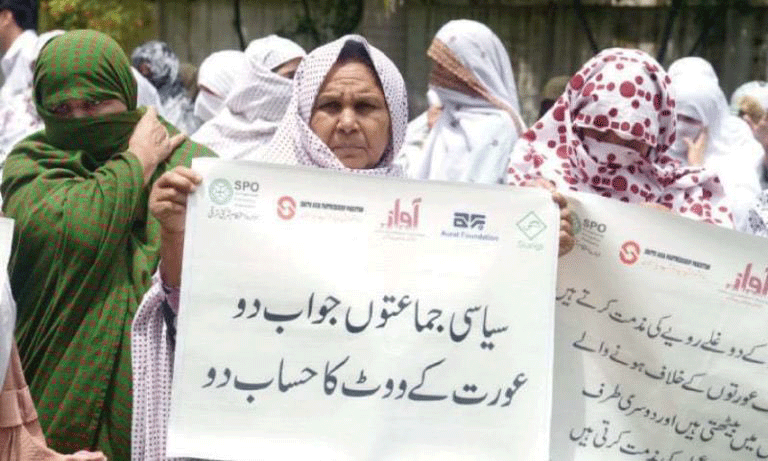One Step Forward, But…
By I. A. Rehman | Special Report | Published 6 years ago

Boosting women’s participation in the electoral process.
The publication of Women in Elections 2018 – a study based on the reports of observers of the 2018 general election – by the National Commission on the Status of Women (NCSW), should serve as a timely reminder of what needs to be done to guarantee an increasing respect for women’s electoral rights.
The author is quite right in viewing the 2018 general election primarily in the context of the emphasis put in the Elections Act of 2017, on widening women’s role in electoral politics. The new provisions of the law on the subject were in relation to the urgency of increasing the number of women voters and obliging each political party registered with the Election Commission of Pakistan (ECP) to allot five per cent of the general seats contested by it to women. One of the provisions also called for the annulment of an election in a constituency where the votes cast by women were less than 10 per cent of the registered votes in that constituency.
Unfortunately, the time period between the adoption of the Elections Act of 2017 and the election itself was too short to call for an accurate assessment of the extent to which the new scheme of things affected the electoral process. Still, the NCSW study does indicate the areas where measures to boost women’s participation in elections should be launched as early as possible.
Let us take for instance, the issue of women’s enrolment as voters. No serious student of demography accepts the official statisticians’ claim that in Pakistan there are 94 women to every 100 males. Likewise, the gap between male and female voters is not accepted as being accurate. In last year’s election, women voters accounted for 44.11 per cent of the total votes, while 55.89 per cent of the voters were men. While women’s share of the total votes was somewhat higher than that in 2013 and 2008 (43.62 per cent and 43.98 per cent, respectively), it was two per cent lower than in 2002 (46.11 per cent). The gender gap in terms of the number of votes increased from 10.97 million in 2013, to 12.5 million in 2018.
We know now where the gender gap in voter registration is more marked than anywhere else. According to the ECP, the best figures of women’s registration are from Islamabad (46.79 per cent), followed by Punjab (44.49 per cent), Sindh (44.46 per cent), Khyber Pakhtunkhwa and FATA (42.71 per cent) and Balochistan (42.18 per cent). What this means is that during the period until the next general election, special efforts must be made to reduce the gender gap in voters’ lists in Balochistan and KP.
The women voters’ turnout in 2018 was impressive. For the first time, gender disaggregated data was available and it showed that 48 per cent of the women voters cast their ballots as against 58 per cent males. In 22 constituencies, there was a higher female turnout than that of males. The highest turnout of women voters was in Tharparkar I and II constituencies (72-83 per cent in NA 221 and 71.4 per cent in NA 222). In 2018, there was no constituency with a female turnout below five per cent, whereas in 2013 there were 17 such constituencies.

The new condition on annulment of results if the votes cast by women were less than 10 per cent of their registered votes, had a positive impact in 2018, according to the report. In the 2013 election, women were barred from voting in 15 constituencies – 10 in Punjab, four in KP and one in FATA. In 2018, a turnout below 10 per cent was reported from five places: Punjab’s Sahiwal and Talagang districts, and KP’s Bannu, Mansehra and Shangla districts. The ECP found re-polling necessary in Shangla.
It should be noted that the decision to fix the minimum necessary level of women turnout at 10 per cent was lower than the 20 per cent level demanded by women’s organisations and their civil society supporters. After a general election or two it should be possible to raise the minimum necessary level of turnout to 20 per cent, or even higher. The ECP is now aware where women turnout is low and it should launch special programmes to achieve a higher turnout.
However, this is not purely an electoral issue. Women’s participation in elections and their ability to vote independently of the dictation of their male family members, will depend upon the degree of freedom that can be achieved from patriarchal, feudal and economic bondage.
Another women-friendly innovation in the new election law, namely the grant of five per cent of party tickets for general seats to women, also produced promising results. Out of the 94 political parties that took part in the 2018 election, six did not put up any woman candidate. Out of the main parties, the PTI barely met the legal requirement, with 5.1 per cent of tickets allotted to women. The parties that did somewhat better were the Muttahida Majlis-Amal (5.3 per cent), the PML-N (5.7 per cent), the PPP (6.2 per cent), the ANP (6.9 per cent) and PSP (7.5 per cent). Six women in the MQM were allotted tickets, eight in the Grand Democratic Alliance (GDA) and 12 in the Tehreek Ya RasoollAllah. Observers noted that most of the women awarded tickets by religious parties took no part in the electoral activity and the idea was merely to convey a message that these parties were not opposed to women’s rights.
Such tactics to meet the legal requirement will continue, as will the practice of nominating well-connected women for reserved seats, so long as political parties do not start activities during inter-election periods and allow women a permanent role in these activities so that they can establish their standing with the electorate.
Additionally, the study by NSCW also offers activists and general readers a wealth of useful information on women’s participation in electoral politics since the 1950s, the problems faced by transgenders and persons with disabilities as voters and candidates and observations made by poll-watchers under various banners. It contains valuable recommendations for the ECP, the administration and civil society.
Mr. I.A. Rehman is a writer and activist living in Pakistan. He is the secretary general of the Human Rights Commission of Pakistan Secretariat.


